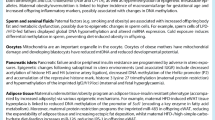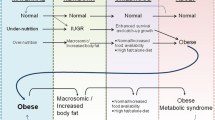Abstract
The link between an adverse intrauterine environment and the development of disease later in life has been observed in offspring of pregnancies complicated by obesity and diabetes, but the molecular mechanisms underlying this phenomenon are unknown. In this review, we highlight recent publications exploring the role of gestational diabetes mellitus in the programming of disease in the offspring. We also review recent publications aiming to identify mechanisms responsible for the “programming effect” that results from exposure to diabetes in utero. Finally, we highlight research on the role of epigenetic regulation of gene expression in an animal model of uteroplacental insufficiency where the offspring develop diabetes as a model by which an exposure to the mother can alter epigenetic modifications that affect expression of key genes and ultimately lead to the development of diabetes in the offspring.

Similar content being viewed by others
References
Papers of particular interest, published recently, have been highlighted as: • Of importance •• Of major importance
Pettitt DJ, Baird HR, Aleck KA, Bennett PH, Knowler WC. Excessive obesity in offspring of Pima Indian women with diabetes during pregnancy. N Engl J Med. 1983;308:242–5.
Pettitt DJ, Aleck KA, Baird HR, Carraher MJ, Bennett PH, Knowler WC. Congenital susceptibility to NIDDM. Role of intrauterine environment. Diabetes. 1988;37:622–8.
Martin AO, Simpson JL, Ober C, Freinkel N. Frequency of diabetes mellitus in mothers of probands with gestational diabetes: possible maternal influence on the predisposition to gestational diabetes. Am J Obstet Gynecol. 1985;151:471–5.
Silverman BL, Metzger BE, Cho NH, Loeb CA. Impaired glucose tolerance in adolescent offspring of diabetic mothers. Relationship to fetal hyperinsulinism. Diabetes Care. 1995;18:611–7.
Atkins V, Flozak AS, Ogata ES, Simmons RA. The effects of severe maternal diabetes on glucose transport in the fetal rat. Endocrinology. 1994;135:409–15.
Plagemann A. Perinatal programming and functional teratogenesis: impact on body weight regulation and obesity. Physiol Behav. 2005;86:661–8.
Simmons RA, Templeton LJ, Gertz SJ. Intrauterine growth retardation leads to the development of type 2 diabetes in the rat. Diabetes. 2001;50:2279–86.
Stoffers DA, Desai BM, DeLeon DD, Simmons RA. Neonatal exendin-4 prevents the development of diabetes in the intrauterine growth retarded rat. Diabetes. 2003;52:734–40.
Barker DJ, Hales CN, Fall CH, Osmond C, Phipps K, Clark PM. Type 2 (non-insulin-dependent) diabetes mellitus, hypertension and hyperlipidaemia (syndrome X): relation to reduced fetal growth. Diabetologia. 1993;36:62–7.
Armitage JA, Taylor PD, Poston L. Experimental models of developmental programming: consequences of exposure to an energy rich diet during development. J Physiol. 2005;565:3–8.
• Pettitt DJ, McKenna S, McLaughlin C, Patterson CC, Hadden DR, McCance DR. Maternal glucose at 28 weeks of gestation is not associated with obesity in 2-year-old offspring: the Belfast Hyperglycemia and Adverse Pregnancy Outcome (HAPO) family study. Diabetes Care. 2010;33:1219. The authors report a significant association with maternal 1-hour blood glucose values during gestational diabetes testing at 28 weeks and offspring BMI z score ≥ 85th percentile at 2 years of age..
• Deierlein AL, Siega-Riz AM, Chantala K, Herring AH. The association between maternal glucose concentration and child BMI at age 3 years. Diabetes Care. 2011;34:480–4. This study found an approximately twofold greater risk of childhood overweight/obesity at 3 years of age when comparing maternal glucose concentrations ≥ 130 mg/dL to maternal glucose concentrations less than 100 mg/dL during gestational diabetes testing at 28 weeks..
Tsadok MA, Friedlander Y, Paltiel O, Manor O, Meiner V, Hochner H, et al. Obesity and blood pressure in 17-year-old offspring of mothers with gestational diabetes: insights from the Jerusalem Perinatal Study. Exp Diabetes Res. 2011;2011:906154.
Crume TL, Ogden L, Daniels S, Hamman RF, Norris JM, Dabelea D. The impact of in utero exposure to diabetes on childhood body mass index growth trajectories: the EPOCH study. J Pediatr. 2011;158:941–6.
• Steculorum SM, Bouret SG. Maternal Diabetes Compromises the Organization of Hypothalamic Feeding Circuits and Impairs Leptin Sensitivity in Offspring. Endocrinology, 2011. This study shows that mice born to diabetic dams display abnormally organized hypothalamic feeding pathways that could result from attenuated responsiveness of hypothalamic neurons to neurotropic actions of leptin during neonatal development. These results indicate that insulin deficiency and hyperglycemia during pregnancy have long-term consequences for metabolic regulation of the offspring.
Jawerbaum A, Capobianco E. Review: Effects of PPAR activation in the placenta and the fetus: implications in maternal diabetes. Placenta. 2011;32 Suppl 2:S212–7.
Holdsworth-Carson SJ, Lim R, Mitton A, Whitehead C, Rice GE, Permezel M, et al. Peroxisome proliferator-activated receptors are altered in pathologies of the human placenta: gestational diabetes mellitus, intrauterine growth restriction and preeclampsia. Placenta. 2010;31:222–9.
Higa R, White V, Martinez N, Kurtz M, Capobianco E, Jawerbaum A. Safflower and olive oil dietary treatments rescue aberrant embryonic arachidonic acid and nitric oxide metabolism and prevent diabetic embryopathy in rats. Mol Hum Reprod. 2010;16:286–95.
•• Pavlinkova G, Salbaum JM, Kappen C. Maternal diabetes alters transcriptional programs in the developing embryo. BMC Genomics. 2009;10:274. This study compares gene expression profiles from mouse embryos exposed to diabetes in pregnancy to control embryos. Embryos exposed to diabetes in pregnancy at gestational day 10.5 had significantly altered gene expression, including 126 genes that were more than twofold changed, when compared with gene expression profiles from control embryos. These results support the idea that embryos exposed to maternal diabetes have altered gene expression profiles that can thereby alter critical developmental pathways in the offspring..
Sproul D, Gilbert N, Bickmore WA. The role of chromatin structure in regulating the expression of clustered genes. Nat Rev Genet. 2005;6:775–81.
Mellor J. The dynamics of chromatin remodeling at promoters. Mol Cell. 2005;19:147–57.
Bernstein E, Allis CD. RNA meets chromatin. Genes Dev. 2005;19:1635–55.
Bannister AJ, Kouzarides T. Reversing histone methylation. Nature. 2005;436:1103–6.
Grady WM, Carethers JM. Genomic and epigenetic instability in colorectal cancer pathogenesis. Gastroenterology. 2008;135:1079–99.
Takahashi T, Shigematsu H, Shivapurkar N, Reddy J, Zheng Y, Feng Z, et al. Aberrant promoter methylation of multiple genes during multistep pathogenesis of colorectal cancers. Int J Cancer. 2006;118:924–31.
So K, Tamura G, Honda T, Homma N, Waki T, Togawa N, et al. Multiple tumor suppressor genes are increasingly methylated with age in non-neoplastic gastric epithelia. Cancer Sci. 2006;97:1155–8.
Yoshida H, Broaddus R, Cheng W, Xie S, Naora H. Deregulation of the HOXA10 homeobox gene in endometrial carcinoma: role in epithelial-mesenchymal transition. Cancer Res. 2006;66:889–97.
Monk M, Boubelik M, Lehnert S. Temporal and regional changes in DNA methylation in the embryonic, extraembryonic and germ cell lineages during mouse embryo development. Development. 1987;99:371–82.
Kafri T, Ariel M, Brandeis M, Shemer R, Urven L, McCarrey J, et al. Developmental pattern of gene-specific DNA methylation in the mouse embryo and germ line. Genes Dev. 1992;6:705–14.
Cedar H, Bergman Y. Linking DNA methylation and histone modification: patterns and paradigms. Nat Rev Genet. 2009;10:295–304.
Gopalakrishnan S, Van Emburgh BO, Robertson KD. DNA methylation in development and human disease. Mutat Res. 2008;647:30–8.
Schubeler D, Lorincz MC, Cimbora DM, Telling A, Feng YQ, Bouhassira EE, et al. Genomic targeting of methylated DNA: influence of methylation on transcription, replication, chromatin structure, and histone acetylation. Mol Cell Biol. 2000;20:9103–12.
Costa FF. Non-coding RNAs, epigenetics and complexity. Gene. 2008;410:9–17.
Costa FF. Non-coding RNAs: new players in eukaryotic biology. Gene. 2005;357:83–94.
Kawasaki H, Taira K. Induction of DNA methylation and gene silencing by short interfering RNAs in human cells. Nature. 2004;431:211–7.
MacLennan NK, James SJ, Melnyk S, Piroozi A, Jernigan S, Hsu JL, et al. Uteroplacental insufficiency alters DNA methylation, one-carbon metabolism, and histone acetylation in IUGR rats. Physiol Genomics. 2004;18:43–50.
Morris KV, Chan SW, Jacobsen SE, Looney DJ. Small interfering RNA-induced transcriptional gene silencing in human cells. Science. 2004;305:1289–92.
Raychaudhuri N, Raychaudhuri S, Thamotharan M, Devaskar SU. Histone code modifications repress glucose transporter 4 expression in the intrauterine growth-restricted offspring. J Biol Chem. 2008;283:13611–26.
Park JH, Stoffers DA, Nicholls RD, Simmons RA. Development of type 2 diabetes following intrauterine growth retardation in rats is associated with progressive epigenetic silencing of Pdx1. J Clin Invest. 2008;118:2316–24.
Fu Q, McKnight RA, Yu X, Wang L, Callaway CW, Lane RH. Uteroplacental insufficiency induces site-specific changes in histone H3 covalent modifications and affects DNA-histone H3 positioning in day 0 IUGR rat liver. Physiol Genomics. 2004;20:108–16.
Li H, Rauch T, Chen ZX, Szabo PE, Riggs AD, Pfeifer GP. The histone methyltransferase SETDB1 and the DNA methyltransferase DNMT3A interact directly and localize to promoters silenced in cancer cells. J Biol Chem. 2006;281:19489–500.
Sharma S, Leonard J, Lee S, Chapman HD, Leiter EH, Montminy MR. Pancreatic islet expression of the homeobox factor STF-1 relies on an E-box motif that binds USF. J Biol Chem. 1996;271:2294–9.
Kouzarides T. Histone methylation in transcriptional control. Curr Opin Genet Dev. 2002;12:198–209.
Bachman KE, Park BH, Rhee I, Rajagopalan H, Herman JG, Baylin SB, et al. Histone modifications and silencing prior to DNA methylation of a tumor suppressor gene. Cancer Cell. 2003;3:89–95.
Bernardo AS, Hay CW, Docherty K. Pancreatic transcription factors and their role in the birth, life and survival of the pancreatic beta cell. Mol Cell Endocrinol. 2008;294:1–9.
Thamotharan M, Shin BC, Suddirikku DT, Thamotharan S, Garg M, Devaskar SU. GLUT4 expression and subcellular localization in the intrauterine growth-restricted adult rat female offspring. Am J Physiol Endocrinol Metab. 2005;288:E935–47.
•• Pinney SE, Jaeckle Santos LJ, Han Y, Stoffers DA, Simmons RA. Exendin-4 increases histone acetylase activity and reverses epigenetic modifications that silence Pdx1 in the intrauterine growth retarded rat. Diabetologia. 2011;54:2606–14. The abnormal intrauterine mileau of IUGR permanently alters gene expression and function of pancreatic β cells leading to the development of diabetes in adulthood. Expression of the pancreatic homeobox transcription factor Pdx1 is permanently reduced in IUGR islets, suggesting an epigenetic mechanism is responsible for the silencing. This study demonstrates a novel mechanism whereby a short treatment course of Ex-4 in the newborn period permanently increases HAT activity by recruiting USF1 and PCAF to the Pdx1 promoter. This restores chromatin structure at the Pdx1 promoter and prevents DNA methylation, thus preserving Pdx1 transcription in IUGR islets..
Disclosure
No potential conflicts of interest relevant to this article were reported.
Author information
Authors and Affiliations
Corresponding author
Rights and permissions
About this article
Cite this article
Pinney, S.E., Simmons, R.A. Metabolic Programming, Epigenetics, and Gestational Diabetes Mellitus. Curr Diab Rep 12, 67–74 (2012). https://doi.org/10.1007/s11892-011-0248-1
Published:
Issue Date:
DOI: https://doi.org/10.1007/s11892-011-0248-1




